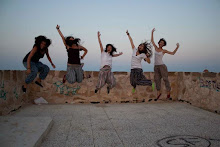There's something about the street
markets of Spain that attract my undivided attention. From the items
sold, to the pedestrians they draw, to their informality, these markets are
simply Spain in a nutshell. I came to
this program for one higher reason: to become a more cultured individual. I have heard these markets are incredibly Spanish,
and they are without doubt a commonality in each city I have visited. From food, to antiques, to music, to weapons,
to clothes, etc., they seem to sell everything under-the-sun. Having walked through these markets in
several different cities, I could not help but ask myself, what makes these
markets so popular, and why are my friends and I so attracted to them?
Above, I mentioned their informality. I mean this in the sense that they are
outdoors, temporary, and do not conform to the conventionalism of a typical
indoor store. These markets are dynamic,
lively and overpopulated with people in a cramped environment. There is no
common entity [aside from the local government to maintain order] that manages
all the independent booths. There is no
formal or main entrance, nor is there a tyrannical arrangement to the items sold. These booths are run by aggressive merchants
who, fair or not, are after your money.
The people who shop at these
markets come from a wide range of backgrounds. In bigger cities like Barcelona,
they are mostly filled with tourists from all over the world. In cities like Guardamar, they are occupied
with a fair share of locals in addition to visitors. Backgrounds aside, however, these markets simply
draw people out of homes and cars to gather in one place, at one time. Humans, social and curious as we are, tend to
be drawn towards large crowds of pedestrians.
In other words, if we happen to walk past a large, lively occurrence
with multitudes of people, we would naturally yearn towards it. This type of event, as William Whyte would
call “triangulation,” is epitomized in the form of a street market.
When I
enter these markets, it is initially as a customer. As a first time visitor of this country, I constantly
yearn for memorabilia that will hold sentimental value for me in remembering
this trip. I can without doubt spend hours
at a time in these markets looking for those types of goods. Once, however, I get over this primitive motive,
I move on to become an observer. Only at
this stage can I truly experience the culture and essence of the places I am
in. Observing the merchants, customers,
pedestrians, tourists, etc., I focus in on transactions, social exchanges,
conversations, body language, and activity of various groups of different backgrounds. As amusing as it can be to people watch, I
genuinely feel connection to a public space/event when I engage it from an
observant point of view. As William
Whyte would most likely say, a successful public space is one that fosters a
sense of belonging. Feelings of inclusion
are generated with the help of social events and occurrences. My friends and I simply feel like we are
included in the rich culture of the Spanish markets.
Posted by: Austin Ng
Posted by: Austin Ng


No comments:
Post a Comment